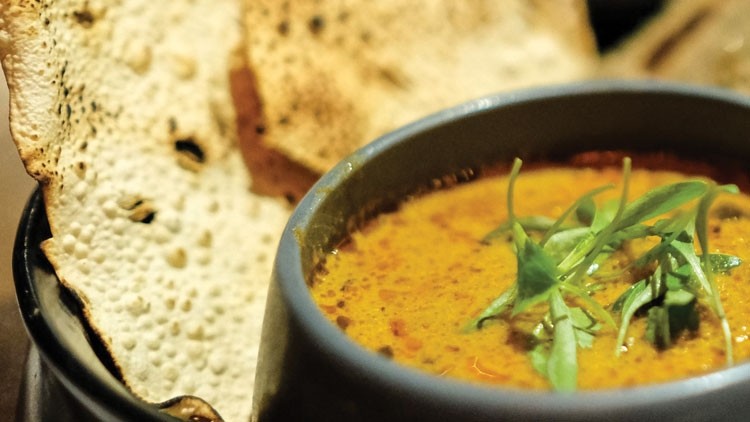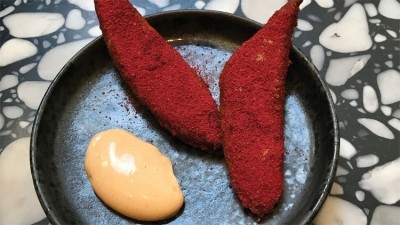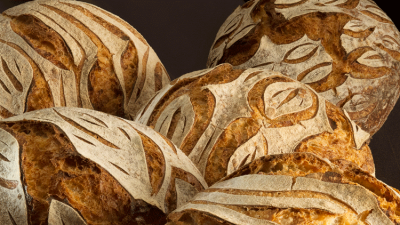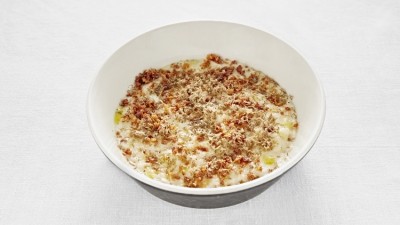Created by Sameer Taneja, Talli Joe
Chef Masterclass: Rajasthani papad ki subz

The co-operative (later named Lijjat Papad, lijjat is the Gujarati word for ‘tasty’) flourished, and the women expanded their business to make many other products, including soaps, detergents and baked goods. In 2010, Lijjat Papad – still a co-operative, wholly owned by its 45,000 ‘member-sisters’ – had a turnover of R6.5bn (about £60m) and is famous throughout India, not just for its papadums but as a template for the successful empowerment of women.
The papadum is ubiquitous in India, made from various flours – skinned urad dal, rice, chickpea, even potato – usually grilled, fried or microwaved until crisp and served as an appetiser or alongside a meal. Rajasthanis eat them that way, too, but they have another technique, as Sameer Taneja, head chef at Talli Joe on Shaftesbury Avenue, explains. “You can also cook them from raw, like pasta, in a curry sauce. It’s called papad ki subz, a classic spicy sauce based on red onion and tomato, rounded and sharpened with yoghurt. The papadums are added just for the last few seconds to soften.
“It’s a classic old recipe. It’s hugely important to preserve dishes like this. We don’t normally use papadums at Talli Joe – we serve a dehydrated dosa instead – but this curry is really popular.”
Rajasthan is an especially arid region, and green vegetables are often thin on the ground, so papad ki subz, with its emphasis on store-cupboard ingredients, is a highly practical standby. Garlic is plentiful, though. “No meal in Rajasthan is complete without garlic pickle, and every family has a different recipe,” says Taneja. “In Ayurvedic terms, it’s considered a ‘cooling’ food.”
Garlic also makes its way into the curry: twice, in fact. Firstly, as one half of the classic ginger/garlic paste, then as part of the tempering at the end, fried in ghee until crisp, with Kashmiri chilli and fenugreek seeds. The idea of tempering, common in Indian cooking, is to use hot fat as a conduit for flavours that add a haunting extra layer of aroma to the dish.
Taneja advises patience when cooking the curry. “Strangely, puréed onions take longer to cook out properly than sliced onions. And go easy on the asafoetida, which is very pungent. Half a teaspoon too much can ruin the dish.”
“It’s important to whisk the yoghurt thoroughly, to help stop it splitting. Simmer the curry gently after you add the yoghurt: but if it does split, don’t worry too much. It won’t affect the flavour.”
You could serve traditionally crisped papadums with the curry, but Taneja likes to make bajra rotis, a bread made with millet flour and potatoes – rather like a gnocchi dough – and flavoured with chilli, ginger and coriander. “It’s a very short dough, so you can’t roll it easily. The traditional method is to shape it into balls and press them flat on a hot grill. In Rajasthan, bajra rotis would be cooked over dung, but electricity or gas are fine!”
And – in solidarity with a remarkable collective of women – do try to find Lijjat Papad’s papadums. Spices of India (www. spicesofindia.co.uk) sells a 200g packet (about 16) for £1.75. Although, admittedly, that is more than twice what it took to launch an extraordinary multi-million pound global business.
Papad ki subz and bajra rotis
Serves 4
Ingredients
For the bajra rotis
200g millet flour
400g cooked and skinned waxy
potatoes, grated
2 tsp finely chopped green chilli
2 tsp finely chopped ginger
2 tbsp chopped fresh coriander
2 tsp salt
For the curry
8 plain papadums
40g ghee (clarified butter)
4g cumin seeds
3g asafoetida
8g chopped green chillies
35g ginger/garlic paste
5g ground coriander
3g Kashmiri chilli powder
3g turmeric
250g fresh vine tomatoes,
puréed in a blender
270g peeled red onions, puréed in a blender
500ml water
200g natural yoghurt, whisked
1g dried fenugreek leaves
15g salt
For the tempering:
5g ghee
1g fenugreek seeds
2 dried Kashmiri chillies, torn in half
7g garlic, finely sliced
Method
1. To make the bajra rotis, bring all the ingredients together in a bowl to form a stiff dough, adding a splash of water if necessary. Knead for a few minutes, then divide into four balls.
2. Heat a tawa, a non-stick or castiron pan until medium-hot, then press each ball down until flat, about ¾ cm thick. Cook until lightly browned, then turn over and cook. Keep warm until needed.
3. For the curry, slice the papadums into quarters and reserve. Heat the ghee in a heavy-bottomed pan until hot, then add the cumin and let it crackle. Add the asafoetida, green chillies and the ginger/garlic paste and stir-fry for 2 minutes.
4. Stir in the coriander, chilli powder and turmeric, then add the tomato and onion purées. Simmer gently for a few minutes and add the water, then simmer for 30 minutes or so until the raw onion flavour has gone.
5. Stir in the yoghurt and dried fenugreek, and simmer gently for 10 minutes. While it cooks, prepare the tempering: heat the ghee in a small pan or metal ladle, then add the fenugreek, chillies and garlic. Cook until the garlic is golden brown, then stir the tempering into the curry.
6. Add the chopped papadums and simmer for 45 seconds until soft. Serve immediately, with the bajra rotis, gently warmed through and painted with a little more ghee.
















